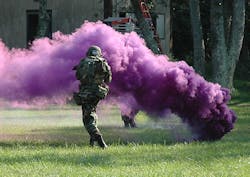Military researchers ask industry to develop tunable, controllable obscurants to hide from infrared sensors
ARLINGTON, Va. – U.S. military researchers are asking industry to develop smoke and other obscurants that degrade an enemy's ability to see the battlefield, but that enable U.S. and allied forces to see the battlefield clearly.
Officials of the U.S. Defense Advanced research Projects Agency (DARPA) in Arlington, Va., have issued a broad agency announcement (HR001122S0007) for the Coded Visibility project.
Obscurants are for confined urban spaces to hide from an adversary's digital infrared sensors and other night-vision systems. Despite decades of development, current obscurants continue to have three critical limitations: they degrade the visual capability of friendly forces and adversaries; their performance is fixed and cannot be tuned in real time; the serious health risks they pose often require using respirators.
Related: Navy looking for new sensor technologies to see through fog, haze, rain, and snow at sea
The goal of the DARPA Coded Visibility program is to address these limitations by developing next-generation obscurants that enable U.S. and allied forces to see, while blocking an adversary's ability to see.
The project seeks to develop obscurants that are tailorable, tunable, and safe, which means the light absorption and scattering performance are controllable, and pose no health risks to those nearby.
Coded Visibility likely will require several types of particulates in one obscurant plume, and will look into the limits of light absorption and scattering. Contractors will design of new particulates, and simulation tools to integrate absorption and scattering from several particulates. Active modulation of tunable obscurants could provide U.S. and allied forces with ways to control obscurants for enhanced visibility.
Related: Navy approaches industry for electro-optical dome of imaging over surface warships
Electromagnetic fields can interact with and manipulate particles to influence their scattering behavior by either modulating the particle’s orientation and position using electric or magnetic fields, or changing the particle's conductivity, absorption, or scattering using electromagnetic sources. Coded Visibility is a 4.5-year project that should start next July.
Proposals for Coded Visibility must address the visible and near-infrared light bands, or the midwave and longwave infrared bands. Several contracts will be awarded.
Companies interested should upload proposals no later than 21 Jan. 2022 to the DARPA BAA website at https://baa.darpa.mil. More information is online at https://sam.gov/opp/19dd0193803843a992d2a7ad444739ae/view.
About the Author
John Keller
Editor-in-Chief
John Keller is the Editor-in-Chief, Military & Aerospace Electronics Magazine--provides extensive coverage and analysis of enabling electronics and optoelectronic technologies in military, space and commercial aviation applications. John has been a member of the Military & Aerospace Electronics staff since 1989 and chief editor since 1995.
